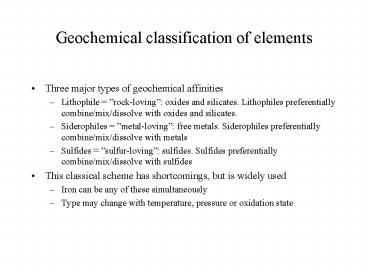Geochemical classification of elements - PowerPoint PPT Presentation
1 / 9
Title:
Geochemical classification of elements
Description:
Lithophiles preferentially combine/mix/dissolve with oxides and silicates. ... Clastic (deposited fragments of older, weathered rock) Organic. Chemical. Classification ... – PowerPoint PPT presentation
Number of Views:3970
Avg rating:3.0/5.0
Title: Geochemical classification of elements
1
Geochemical classification of elements
- Three major types of geochemical affinities
- Lithophile rock-loving oxides and silicates.
Lithophiles preferentially combine/mix/dissolve
with oxides and silicates. - Siderophiles metal-loving free metals.
Siderophiles preferentially combine/mix/dissolve
with metals - Sulfides sulfur-loving sulfides. Sulfides
preferentially combine/mix/dissolve with sulfides - This classical scheme has shortcomings, but is
widely used - Iron can be any of these simultaneously
- Type may change with temperature, pressure or
oxidation state
2
Mineral classes
- Native elements Cu, Au, Ag
- Sulfides (S2-) pyrite FeS2
- Oxides and hydroxides (O2-, OH-) hematite Fe2O3,
brucite Mg(OH)2 - Halides (Cl-, F-, Br-, I-) halite NaCl (salt)
- Carbonates (CO32-) calcite CaCO3
- Sulfates (SO42-) barite BaSO4
- Phosphates (PO43-) apatite Ca5F(PO4)3
- Silicates (SiO44-) quartz SiO2, pyroxene
(Mg,Fe)SiO4, olivine (Mg,Fe)2SiO4, Na-feldspar
NaAlSi3O8
3
Important silicate groups
Olivines (dark and/or green)
Feldspars (Fe-free, light)
Pyroxenes
4
Rocks
- Composed of assemblages of different minerals
- Four major groups
- Primitive
- Igneous
- Metamorphic
- Sedimentary
5
Primitive rocks
- Formed directly from material condensed in the
solar nebula - Have not undergone subsequent transformations
- Common on asteroids and in meteorites
- Chondrites have the same refractory element
abundances as the Sun
6
Igneous rocks
- The most common rock type on objects that have
undergone melting - Formed from cooling magma
- Intrusive or plutonic crystallized slowly at
depth, coarse grained (granite) - Extrusive or volcanic crystallized rapidly on or
near the surface, fine grained (basalt) - Classification according to decreasing silica
content - Acidic, intermediate, basic, ultra-basic
7
Metamorphic rocks
- Altered by chemistry, pressure or temperature
following initial crystallization (gneiss) - Formed near the surface
- May be created by impact-induced shocks
8
Sedimentary rocks
- Formed under moderate pressure by accumulation of
igneous, metamorphic or sedimentary mineral
grains or organics - Three major types
- Clastic (deposited fragments of older, weathered
rock) - Organic
- Chemical
9
Classification based on origin
Classification based on texture and acidity

